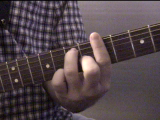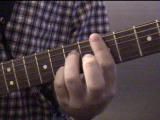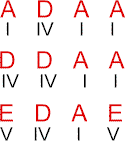Scroll through the lesson and click on notation/video/audio links to load the interactive players.
Please subscribe to get full access to all lessons for only $7.95/month PLUS 1 week free trial.

Riff Interactive lessons are
LESS expensive and
MORE interactive than alternatives!
More Info
|
|
| Lesson Subject:
Lead Guitar Styles |
| What you learn:
Blues Lead Guitar |
| Teacher:
Storm Stenvold |
Storm: Hi. I'd like to thank all the Blues fans
for tuning in this lesson. In this lesson we will look into Blues Lead
guitar.
Storm:
I'm sending out the jam track for the licks and ideas we'll work
on. The jam track is a progression that has
been called the 'Song of the Twentieth Century': The '12-Bar
Blues'. This is in the key of 'A' if you want to
get soloing right away!
Storm:
Here are some stock voicings for the three chords that make up the progression.
A D E. All are 'dominant' chords.
A7

Andy: What does dominant mean?
Storm: Dominant is a type or 'quality' of
chord, like minor or major.
D7

Storm: The jam track uses some extensions of
these basic chords. The next tab and video clip show an example of the
riff.
Storm:
OK. The move on 'E' sounds just like the 'D' move, just up two frets. The next
graphic shows the order of the changes. 'A' for the first four
bars. 'D' for the next two, back to 'A' for
two bars. Then finishing with a flourish, 'E' for
a bar, 'D' for a bar, then 'A' finally
'E'.
12-Bar
Progression in 'A'.

Storm: The last two bars are known as the
'turnaround'. Then right back to the
top. Notice much of the progression centers
on 'A' and 'D'. Much of the lesson will be working out licks to these chords.
Much of what works for 'D' can be transposed up two positions to work on
'E'.
Storm:
This is the 'Blues Scale' in the key of 'A'. Seems to be a logical first choice,
no? This is the most popular scale for
guitar solos. The highlighted note is the 'b5' or 'blues' note. It is that
additional note that makes this scale different than the 'Minor
Pentatonic'. This scale works well over the entire
progression. It really is the core sound of blues melody. It is difficult to hit
a really bad note if one stays within this scale. It is a must-know scale for this style,
and many others. You should practice playing the blues
note with hammer-ons, pull-offs and
bends. Here a some extension
patterns.
Storm:
Same notes, higher up the neck. This, as I mentioned, works over the
entire progression. There are 'target' notes for each of the chords, though. We
will work on some of these phrases coming
up. Here comes another scale
option.
Storm:
This is the Major Pentatonic scale in our key of 'A'. Notice that it has the same pattern as
'Minor' Pentatonic but moved down three positions. The root note 'A' is
highlighted. Very helpful if you can mentally, visually, aurally highlight this
note yourself.
Storm:
Here are some extensions for the Major Pentatonic. These are nice to break out of a rut.
Try to visualize these laying over or 'on top' of your Minor Pentatonic
patterns. Use this scale is against the 'A' chord.
A 'sweeter' or 'happier' sound. Then switch to the Minor Pentatonic or
Blues Scale for the 'D' and 'E' changes. And back again.
Storm:
Or combine them together. The blues scale, again, always works,
but the Major Pentatonic's '3rd' is a real clunker of a note over the 'D' chord
change. To continue breaking out of the same
boxes, lets look at some target notes, the chord tones of the
progression.
Buud: Is that sort of a "rule" to use the major against
the I chord, and the minor pentatonic against the IV and
V?
Storm:
Yeah, especially when D or E come along, GET OFF THE MAJOR
PENTATONIC! If you follow that 'rule' you should
hear new lines developing in your
soloing.
Andy:
Are these the same as arpeggios?
Storm: Yes. But try to find these notes within
the two pentatonic patterns as well. On 'A' or the I chord there is the Root,
Maj 3rd, 5th and b7. The Maj 3rd is that target note, though
the others are strong as well. For the D chord the b3 of the blues
scale is very strong as is the 4th. Let me send some
licks.
Buud: Is
aiming for the maj 3rd as the target tone the feature that gives a lick the
"blues" tonality?
Storm:
Buud, you will get a sweeter sound.
Storm:
BB King uses the major Pentatonic a lot. Some players use it more than others. I
think it gives your sound more variety. Albert King uses the Blues scale almost
exclusively, though. And he is incredible, too.
Andy: As
long as you're just playing blues?
Andy: or rock
or country?
Storm: Well, Andy, Major Pentatonic does not
work well over 'minor' progressions. But Minor Pentatonic can be worked over
'major' progressions.
Storm:
One note that kind of splits the difference is the 'blues
third'.
Storm:
It is reached by bending the Minor third of the Minor Pentatonic 1/4
step. Not quite minor, not quite major, but
all-American! Another cool combination pattern to try.
The highlighted notes are in the Major Pentatonic. They are the '6' and the
'2'. The '6' is a very strong note over the D
change as well, the 3rd of the IV chord. To get more note choices try the seven
note 'diatonic' scale for dominant chords. The Mixolydian
mode.
Storm:
Again these notes sound fitting against the I chord 'A' but to navigate the
12-Bar Progression you now need to switch scales as the chords
change.
Storm:
This lick changes from 'A' to 'D' Mixolydian as the chords change from A to D.
Try it over the first two measures of the jam track. Along this line lets finish up with some
two note patterns, double-stops. These are double-stop 'thirds' and can
really fatten up your soloing.
Storm:
If these are new don't expect to get them in a minute. I strongly suggest
learning them with the fingerings given. Again as the chords change you need to
change patterns. But they really are the same pattern just in different
positions.
Storm:
Another double stop pattern of 'sixths'. Another nice sound. The names 'thirds'
and 'sixths' come from how far apart they are in the major scale. Called an
'interval'.
Storm:
A sixths riff.
Storm:
Finally, a lick for the last two bars of the progression, the turnaround. And it
uses 6ths! OK. Thanks for joining me and have fun
jamming to this track. Remember that the most important part of
the blues can't be put on paper. It is the emotion necessary to really
play the style well. The best idea is to really immerse
yourselves in good blues music. We will get a little more 'out' next
week with Jazz-Rock soloing. All the blues stuff will come into play on that,
too.
Storm: Usually does. Take
care.
|
<< load notation from left
|
|
<< load audio from left
|
<< load audio from left
|